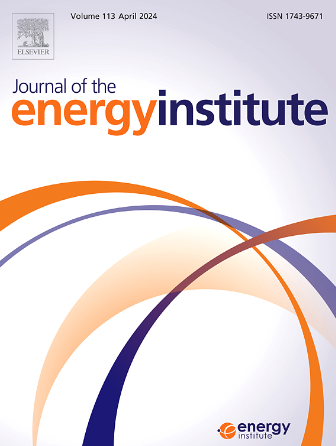Pyrolysis characteristics of blended textile in waste clothing
IF 5.6
2区 工程技术
Q2 ENERGY & FUELS
引用次数: 0
Abstract
The pyrolysis of blended textiles from waste clothing was studied to advance the technology for recycling such materials. Waste garments made of polyester/cotton, a common blended textile, were used as experimental samples. The pyrolysis properties of polyester/cotton were examined using thermogravimetric analysis (TGA) and laboratory-scale pyrolysis experiments. The thermogravimetric (TG) curve indicated that the pyrolysis of polyester/cotton began at 255.1 °C and ended at 471.7 °C. The pyrolysis derivative curve for polyester/cotton displayed three peaks, with the most significant peak at 353.8 °C and minor peaks at 319.9 °C and 403.4 °C. Laboratory-scale pyrolysis experiments were then performed at heating temperatures of 400, 500, 600, and 700 °C. The pyrolysis products were characterized by analyzing the char, tar, and gas generated. The polyester/cotton char exhibited a high higher heating value (HHV) of 32,640 J/g-char (db) at 600 °C. The tar composition revealed that the polyester/cotton char was primarily composed of fragments with a phenyl structure derived from polyester, with benzoic acid being a notable tar component. This composition was marked by significant production of polycyclic aromatic hydrocarbons, even at pyrolysis temperatures below 700 °C. The main components of the pyrolysis gases were CO2 and CO at low and high temperatures of 400 and 700 °C, respectively. By summarizing the composition of tar and gas in relation to pyrolysis temperature, a mechanism was proposed in which interactions between the hydroxyl groups in the molecular structure of cotton and the benzene rings in the molecular structure of polyester during pyrolysis lead to CO formation. These findings contribute to the development of recycling technologies for utilizing waste clothing as an energy source and chemical feedstock.
求助全文
约1分钟内获得全文
求助全文
来源期刊

Journal of The Energy Institute
工程技术-能源与燃料
CiteScore
10.60
自引率
5.30%
发文量
166
审稿时长
16 days
期刊介绍:
The Journal of the Energy Institute provides peer reviewed coverage of original high quality research on energy, engineering and technology.The coverage is broad and the main areas of interest include:
Combustion engineering and associated technologies; process heating; power generation; engines and propulsion; emissions and environmental pollution control; clean coal technologies; carbon abatement technologies
Emissions and environmental pollution control; safety and hazards;
Clean coal technologies; carbon abatement technologies, including carbon capture and storage, CCS;
Petroleum engineering and fuel quality, including storage and transport
Alternative energy sources; biomass utilisation and biomass conversion technologies; energy from waste, incineration and recycling
Energy conversion, energy recovery and energy efficiency; space heating, fuel cells, heat pumps and cooling systems
Energy storage
The journal''s coverage reflects changes in energy technology that result from the transition to more efficient energy production and end use together with reduced carbon emission.
 求助内容:
求助内容: 应助结果提醒方式:
应助结果提醒方式:


